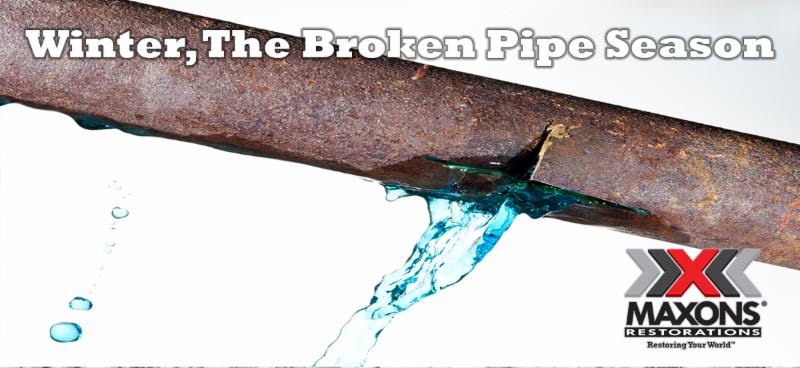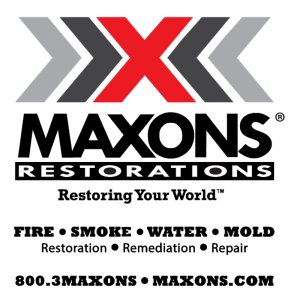Would You Know If You Had A Broken Pipe?

When the temperatures drop below freezing, water inside pipes can freeze and expand. If water expands too much, it can crack the pipe, and also cause an ice blockage which in turns causes water pressure to increase further down the pipe. The damage often goes unnoticed until the weather warms up and the water thaws–causing pipes to burst.
The pipes most at risk are those that are not protected along their entire length by the building insulation or insulation on the actual pipe itself.
Here are some warning signs that you may be dealing with a broken pipe:
Sounds That Can Indicate Broken Pipes
Bubbling Noises: When you flush the toilet or use the sink, air that cannot escape to the sewer lines will create a bubbling noise. This can be a sign that there is a pipe broken, and it should be inspected.
- Whistling Noises: If a pipe gets dented, it can create a segment of pipe that is too small for the volume of water that needs to travel through it and when it does it can emit a whistling sound. If a whistling sound suddenly occurs, it should be checked out, as soon as possible. Increased water pressure on compromised pipes can cause the pipe to burst.
- Banging or Clanking: If loose pipes bump into one another, a clanking noise will be the result. Whether due to loose washers or other worn parts, loose pipes can cause tension that can lead to holes or leaks.
If you hear any of these noises, have your pipes inspected.
Sights & Smells That Can Indicate Broken Pipes
- Unpleasant Odor: If drains, sinks, or any area of your property has an unpleasant odor, especially on the lowest floor, it can be a sign that a pipe is backed up or broken. The odor is a sign that sewage is not being successfully transported from your pipes to the municipal sewer lines.
- Sink Holes: If you have sink holes, or any unexplained soggy or wet areas in your lawn, there may be a break in the main pipes underground.
- Puddles: If water is accumulating anywhere in your property, especially under sinks or on floors, a pipe may be broken. Some may be easy to detect and see, such as pipes under the sink or the water supply to the toilet, but others may be behind walls or ceilings.
- Damp Drywall: If the drywall is damp anywhere in your property, or if there are wet rings on the ceiling, this is a sure indicator of a broken or burst pipe.
If you see or smell anything it is best to have it checked out as quickly as possible.
Other Signs of a Broken Pipe
- Persistent Clogs: Whether it is a clogged drain or a slow-flushing toilet, any problem that is persistent is an indicator that something is wrong. Broken pipes and blockage are not the only reasons these conditions will exist, but they should not be ruled out.
- Frequent Backups: If basement drains, laundry tubs, or other drains have frequent backups or there are water stains around any of the drains and you have not used them, this can be an indicator that the sewage lines are broken or blocked.
- No Water: If you turn on the faucet, laundry machine, or dishwasher and no water comes out or the pressure is very low, pipes may be frozen, or there may be a broken pipe underground. There are many new technologies to repair underground pipes that have broken without digging them up.
- Poor Water Quality: If the water suddenly turns color or begins to smell, this can be an indicator that the pipes have begun to corrode or otherwise become contaminated or deteriorated.
- High Water Bill: If your water bill is significantly higher than usual without any unusual activity, it may be an indicator of a broken pipe. Physical indicators such as puddles, odors, or damp drywall will usually show themselves first, but in cases when breaks remain undetected, escalated bills can help detect problems.
What To Do If Your Pipes Freeze
- Keep the faucet open. As you treat the frozen pipe and the frozen area begins to melt, water will begin to flow through the frozen area. Running water through the pipe will help melt ice in the pipe.
- Apply heat to the section of pipe using an electric heating pad wrapped around the pipe, an electric hair dryer, a portable space heater (kept away from flammable materials), or by wrapping pipes with towels soaked in hot water. Do not use a blowtorch, kerosene or propane heater, charcoal stove, or other open flame device.
- Apply heat until full water pressure is restored. If you are unable to locate the frozen area, if the frozen area is not accessible, or if you can not thaw the pipe, call a licensed plumber.
- Check all other faucets in your property to find out if you have additional frozen pipes. If one pipe freezes, others may freeze, too.
Addressing problems with the water supply or drainage quickly is important to help prevent mold growth. Preventing problems from occurring or preventing them from getting worse will help keep your property safe and healthy for everyone.
If you need emergency help with property damage call 800.3MAXONS (800.362.9667)
Stay safe


